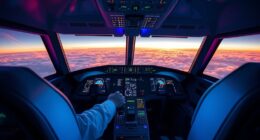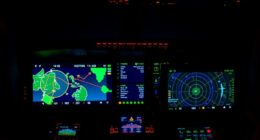When I first set foot on a glider and experienced the exhilaration of soaring through the sky, I knew I had found my passion.
If you’re like me and are eager to learn how to glide, then this guide is for you. In this article, I will provide you with a comprehensive overview of gliding schools and training programs.
From the types of schools available to the safety measures and regulations, we will explore everything you need to know to make an informed decision.
Get ready to spread your wings and take flight!
Key Takeaways
- When choosing a gliding school, it is important to consider factors such as accreditation, experienced instructors, safety record, and facilities.
- The qualifications and experience of instructors play a crucial role in the quality of training programs, including their adaptability to different learning styles and their knowledge of gliding and teaching techniques.
- Safety should be a top priority when selecting a gliding school, and it is essential to research the school’s safety record, inspect equipment conditions, and ensure comprehensive emergency procedures are in place.
- Glider pilot license requirements include age restrictions, medical requirements, flying experience prerequisites, and written and practical exams. These requirements may vary by country or organization.
Types of Gliding Schools
There’s a wide range of gliding schools available for aspiring pilots to choose from. When considering gliding school options, it’s important to look at the benefits of the training program.
One option is a local gliding club, which often offers affordable lessons and a supportive community of fellow pilots. These clubs typically have experienced instructors who are passionate about teaching others how to glide.
Another option is a commercial gliding school, which might have more resources and a more structured training program. These schools often provide a comprehensive curriculum and access to modern gliders and equipment. Some even offer accelerated programs for those looking to obtain their glider license quickly.
Additionally, there are specialized schools that focus on specific types of gliding, such as aerobatic or cross-country gliding. These schools provide targeted training in their respective disciplines.
When choosing a gliding school, it’s important to consider factors such as location, cost, reputation, and the specific goals you have for your gliding journey.
Factors to Consider When Choosing a Gliding School
When choosing a gliding school, there are several important factors to consider.
One key aspect is the accreditation and certifications held by the school. This ensures that the school meets certain standards of quality and safety in its operations.
Another important factor is the experience and qualifications of the instructors. It is crucial to have instructors who are knowledgeable, experienced, and have the necessary certifications to teach gliding.
Lastly, the safety record and facilities of the school should be thoroughly evaluated. This includes looking into the school’s safety procedures, maintenance practices, and the condition of their gliders and equipment.
Accreditation and Certifications
Accredited gliding schools offer certifications that ensure high-quality training programs. The accreditation process involves meeting industry standards and undergoing rigorous evaluations to ensure the school’s adherence to safety and instructional guidelines.
These certifications provide students with the confidence that they are receiving proper training from qualified instructors in a safe and controlled environment. When considering gliding schools, it is essential to look for those that are accredited by reputable organizations such as the Soaring Society of America or the British Gliding Association.
These organizations set the standards for gliding instruction and regularly assess schools to maintain their accreditation. By choosing an accredited school, aspiring glider pilots can have peace of mind knowing that their training will be comprehensive, professional, and in line with the highest industry standards.
Instructor Experience and Qualifications
To ensure you receive the best instruction possible, it is important to consider the experience and qualifications of the instructors. When it comes to gliding schools and training programs, the expertise of the instructors plays a crucial role in your learning journey. Here are some key factors to consider:
-
Instructor Training: Look for instructors who have undergone comprehensive training programs that focus on both technical knowledge and practical skills. This ensures that they are well-equipped to teach and guide you throughout your training.
-
Instructional Techniques: Pay attention to the instructional techniques used by the instructors. Effective instructors should be able to break down complex concepts into easily understandable parts, provide clear and concise instructions, and adapt their teaching methods to suit individual learning styles.
-
Experience: Consider the experience level of the instructors. Look for those who have not only a strong background in gliding but also ample experience in teaching others. Experienced instructors bring a wealth of knowledge, insights, and real-world examples to enhance your learning experience.
Safety Record and Facilities
Ensure your safety by considering the gliding school’s safety record and facilities. When choosing a gliding school, it is essential to research their safety record and inspect their facilities.
Look for a school that prioritizes safety and maintains their gliding school equipment regularly. The equipment should be in good condition, with no visible signs of damage or neglect. Additionally, inquire about the emergency procedures in gliding. A reputable school will have well-defined emergency protocols in place, ensuring that you are prepared for any unforeseen circumstances.
Ask about the training provided to handle emergencies and how often they are practiced. A gliding school with a strong safety record, well-maintained equipment, and comprehensive emergency procedures will provide you with a secure and enjoyable learning experience.
Glider Pilot License Requirements
When it comes to obtaining a Glider Pilot License, there are a few key requirements to keep in mind.
Firstly, there are age and health restrictions that must be met in order to qualify for the license.
Additionally, flying experience prerequisites are necessary, as well as passing both written and practical exams.
These factors play a crucial role in determining whether or not an individual is eligible to pursue a Glider Pilot License.
Age and Health Restrictions
Before signing up for a gliding program, make sure you meet the age and health restrictions. It is important to ensure that you are eligible to participate in glider training before investing your time and money. Here are some key points to consider:
-
Age Restrictions: Gliding programs typically require participants to be at least 14 years old. However, the exact age limit may vary depending on the specific gliding school or training program.
-
Medical Requirements: Glider pilots need to meet certain medical standards to ensure their safety and the safety of others. A medical certificate from an aviation medical examiner is usually required to prove that you are fit to fly.
Flying Experience Prerequisites
When it comes to pursuing a career in gliding, there are certain flying experience requirements and pilot license prerequisites that you need to fulfill.
To obtain a glider pilot license, you must meet a minimum flight time requirement, typically around 40 to 60 hours of flight experience. This includes both solo and dual flights, where you are accompanied by an instructor.
In addition to flight time, you will also need to pass a written exam and a practical flight test. These exams assess your knowledge of glider operations, meteorology, navigation, and safety procedures.
It is important to note that the specific requirements may vary depending on the country or organization you are training with. Therefore, it is crucial to research and understand the flying experience prerequisites for your chosen gliding school or training program before getting started.
Written and Practical Exams
To pass the written and practical exams, you’ll need to demonstrate your knowledge and skills in glider operations, meteorology, navigation, and safety procedures. These exams are designed to ensure that you have a strong foundation in the essential areas of gliding.
Here are three key areas that the exams will cover:
-
Glider operations: You’ll be tested on your understanding of glider controls, flight maneuvers, and emergency procedures.
-
Meteorology: This section will assess your knowledge of weather patterns, thermals, and other factors that affect gliding conditions.
-
Navigation: You’ll need to demonstrate your ability to plan and execute flights, using instruments and charts to navigate accurately.
Successfully passing these exams is crucial as they lay the groundwork for your gliding journey.
Now, let’s dive into the curriculum and training programs that will help you prepare for these exams and become a skilled glider pilot.
Curriculum and Training Programs
The curriculum at our gliding school includes both theoretical and practical training. We believe that a well-rounded education is essential for our students to become skilled gliders.
In the theoretical portion of the program, we cover a wide range of topics, including the principles of flight, aerodynamics, meteorology, navigation, and gliding techniques. Our experienced instructors use interactive lectures, videos, and hands-on activities to ensure that students grasp these concepts effectively.
When it comes to practical training, we provide our students with state-of-the-art equipment to enhance their learning experience. Our gliders are equipped with advanced instruments and technology that allow students to develop their flying skills and gain confidence in the cockpit. From the very beginning, our students are taught how to perform pre-flight inspections, control the glider during takeoff and landing, and execute various maneuvers in the air.
As we prioritize safety at our gliding school, we ensure that all students are aware of the safety measures and regulations that govern gliding. By establishing a strong foundation in safety practices, we can create a secure learning environment for our students. From regular equipment inspections to comprehensive safety briefings, we leave no stone unturned in our commitment to keeping our students safe.
Safety Measures and Regulations in Gliding Schools
When it comes to gliding schools, safety is of utmost importance. Gliding may seem like a thrilling and adventurous activity, but it can also be risky if proper safety measures and protocols are not followed. Gliding schools have strict safety protocols in place to ensure the well-being of both instructors and students.
Here are some of the safety measures and emergency procedures that you can expect to find at a reputable gliding school:
-
Pre-flight inspections: Before every flight, gliders undergo thorough inspections to ensure they are in proper working condition. This includes checking the control surfaces, instruments, and safety equipment.
-
Safety briefings: Prior to flying, instructors provide detailed safety briefings to students. This includes information on emergency procedures, proper use of safety equipment, and the importance of following instructions.
-
Emergency response plans: Gliding schools have well-defined emergency response plans in place. Instructors and staff are trained to handle various emergency situations, such as engine failures, landing gear malfunctions, or inclement weather conditions.
Evaluating Instructor Qualifications and Experience
Evaluating instructor qualifications and experience is essential for ensuring a safe and knowledgeable learning environment in gliding. When it comes to evaluating teaching methods, it is important to consider the instructor’s ability to effectively communicate and demonstrate techniques. A skilled instructor should be able to break down complex concepts into easily understandable steps. They should also have a variety of teaching strategies to accommodate different learning styles.
Another important factor to consider is the student to instructor ratio. A low student to instructor ratio allows for more individualized attention and feedback, which can greatly enhance the learning experience. It is recommended to look for gliding schools that maintain a small class size, ensuring that each student receives adequate time and attention from the instructor.
To help you evaluate instructor qualifications and experience, here is a table that outlines key criteria to consider:
| Criteria | Qualifications |
|---|---|
| Flight Experience | Number of hours |
| Certification | Licenses held |
| Teaching Experience | Number of years |
| Safety Record | Accident history |
Financial Considerations and Payment Options
To help you make an informed decision, it’s important to consider the financial aspects and available payment options for your gliding experience.
When it comes to financing your training, there are several options to consider:
-
Payment Options: Many gliding schools offer flexible payment plans, allowing you to spread out the cost of your training over a period of time. This can help ease the financial burden and make it more manageable.
-
Financial Assistance: Some gliding schools may offer scholarships or grants to assist with the cost of training. These financial assistance programs can be a great way to offset the expenses and make gliding more accessible to a wider range of individuals.
-
Sponsorship Opportunities: Another option to explore is sponsorship. Some companies or organizations may be willing to sponsor your gliding training in exchange for advertising or promotional opportunities. This can be a win-win situation, as it provides financial support for your training while also giving the sponsor exposure.
Considering the available payment options and financial assistance programs can help make your gliding dreams a reality.
Now, let’s delve into the experiences of past students and their success stories.
Student Testimonials and Success Stories
Immerse yourself in the inspiring stories and testimonials from past students who have achieved great success in their gliding journeys. Gliding schools and training programs provide students with the knowledge and skills necessary to pursue a career in this exhilarating sport. The achievements of these students showcase the vast potential and opportunities that await those who embark on this path.
To give you a glimpse of the remarkable accomplishments of these gliding enthusiasts, here are a few testimonials from former students:
| Name | Achievement | Career Opportunity |
|---|---|---|
| Sarah Adams | Won first place in national gliding competition | Instructor at a prestigious gliding school |
| John Parker | Completed a solo cross-country flight | Pilot for a commercial gliding company |
| Emily Chen | Set a new altitude record for her region | Aerobatic glider pilot for airshows |
| Michael Lee | Earned a glider pilot license at age 17 | Instructor at a local gliding club |
| Jessica Wong | Represented her country in international gliding competitions | Aerospace engineer specializing in glider design |
These incredible achievements demonstrate the diverse range of career opportunities available to those who pursue gliding. Whether it be instructing, piloting, or engineering, gliding opens doors to a world of possibilities. The stories of these successful students serve as a testament to the dedication and passion required to excel in this field. So, why not join them and embark on your own gliding journey? The sky is the limit!
Frequently Asked Questions
Are There Any Age Restrictions for Enrolling in a Gliding School?
There aren’t any age restrictions for enrolling in a gliding school. This is great because young pilots can benefit greatly from glider training.
It provides them with a unique opportunity to learn the fundamentals of flight without the distractions and complexities of powered aircraft. Glider training builds a solid foundation of aviation knowledge and skills, which can be applied to other types of flying later on.
How Long Does It Typically Take to Obtain a Glider Pilot License?
Obtaining a glider pilot license typically takes a significant amount of time and effort. The average training time can vary depending on the individual’s dedication and aptitude for flying.
It involves both theoretical and practical lessons, covering topics such as aerodynamics, meteorology, and navigation. Additionally, there are practical flight hours that need to be completed.
The cost of obtaining a glider pilot license can also vary, depending on the specific gliding school and training program.
Is It Possible to Transfer Credits or Hours From One Gliding School to Another?
Yes, it’s possible to transfer credits or hours from one gliding school to another. The transferability of training depends on the specific gliding schools and their policies.
Before transferring, it’s important to compare the curriculums of the gliding schools to ensure that the credits or hours earned will be recognized by the new school.
It’s recommended to contact both the current and prospective gliding schools to discuss the transfer process and requirements.
What Type of Medical Certificate Is Required to Participate in Glider Training Programs?
To participate in glider training programs, a medical certificate is required. The type of medical certificate needed will depend on the country’s aviation regulations. These requirements ensure that individuals are physically fit to safely operate a glider.
The medical certificate typically involves a thorough examination conducted by a certified aviation medical examiner. It is important to check with the specific glider training program or the aviation authority in your country for the exact requirements and certification process.
Can International Students Enroll in Gliding Schools and Obtain a Glider Pilot License?
Yes, international students can certainly enroll in gliding schools and obtain a glider pilot license. The process may vary depending on the specific school and country, but many gliding schools welcome students from around the world.
Obtaining a glider pilot license as an international student may require additional paperwork and documentation, such as a valid visa and proof of English proficiency.
It’s important to research and contact the gliding school directly for more information on their specific requirements and enrollment process.
Conclusion
In conclusion, embarking on a gliding journey is like spreading wings and soaring through the sky.
With a myriad of gliding schools to choose from, it’s crucial to consider factors such as safety measures, instructor qualifications, and financial considerations.
By immersing yourself in a reputable training program, you’ll be equipped with the knowledge and skills to earn your glider pilot license.
So take the leap, join the ranks of successful glider pilots, and let the wind guide you to new heights of exhilaration and freedom.



